When you are looking to give new life to an old piece of furniture, upholstery, or even clothing, fabric paint can be a great option. But what about leather? Can you use fabric paint on leather? The answer is yes – but there are a few things you need to know first. This article will discuss the truth about fabric paint and leather. It will cover everything from how to prep the surface to what types of paint work best on leather.
Does Fabric Paint Work On Leather?
Fabric paint can work on leather, but it’s not the ideal choice. The paint can flake off over time and damage the leather. If you do decide to use fabric paint on leather, make sure you test it in an inconspicuous spot first and be prepared for it to eventually wear off. Fabric paint is usually made with synthetic fiber that doesn’t breathe well. This can cause the paint to crack and peel off the leather over time [1].
Which Paint Is Compatible With Leather?
Acrylic paint is the best choice for painting leather. It’s flexible and won’t crack or peel as fabric paint can. It is made of natural fibers, which means it will allow the leather to “breathe” and won’t trap moisture. It’s also water-based so it won’t damage the leather-like oil-based paints. You can find acrylic paint at any craft store. Just make sure to read the labels carefully to make sure the paint is compatible with leather.
How To Prepare Leather Before Painting?
Before you start painting, it’s important to clean the leather. This will help the paint adhere better and give you a more even finish. You can clean the leather with a mild soap and water solution. Just be sure to dry it thoroughly before starting to paint.

How To Paint Leather?
Now that your leather is clean and dry, you’re ready to start painting. Apply a thin layer of acrylic paint to the leather using a brush or sponge. Work in small sections so the paint doesn’t have a chance to dry before you’ve had a chance to spread it evenly. Once the first layer is dry, apply another thin layer until you’re happy with the coverage. Allow the paint to completely dry before using the item.
Painting Leather can be used in different projects. You can use this method to change the color of your shoes, handbags, or furniture. You can also use it to add a personal touch to any leather item. Just be sure to use the right paint and prepare the leather properly for the best results.
Should You Wet the Leather Before Applying Paint?
You should not wet the leather before applying paint. The water will cause the paint to run and won’t allow it to adhere properly to the leather. If you’re working with a large area, you can dampen a sponge and use that to wet the leather instead of using a spray bottle. Just be sure to wring out the sponge well before using it on the leather.
What Type of Brush Should You Use To Apply Paint?
The best type of brush to use when painting leather is a synthetic brush. Natural bristle brushes can shed into the paint and leave bristles behind on the leather. This will ruin the look of your project and make it more difficult to use the item. Synthetic brushes are also less likely to absorb the paint, which means you’ll use less paint overall.
Is Fabric Paint Compatible With Other Fabrics?
Fabric paint is compatible with other fabrics. You can use it to add a pop of color to clothing, curtains, or upholstery. Just be sure to test the paint in an inconspicuous spot before starting your project. Fabric paint is also great for adding personalization to items like backpacks, totes, and more.
What Are the Advantages and Disadvantages of Using Fabric Paint?
Using fabric paint can have different advantages and disadvantages, depending on what type of project you are working on.
Some advantages include:
- Fabric paint can be less expensive than other types of paint;
- Fabric paint is typically easy to find and purchase;
- Fabric paint can be applied in a wide variety of ways, giving you more creative control over your project;
Some disadvantages of using fabric paint include:
- Fabric paint is not as durable as other types of paint, so it is not ideal for projects that will see a lot of wear and tear;
- Fabric paint can be more difficult to remove from clothing and other fabrics if it gets spilled or splattered;
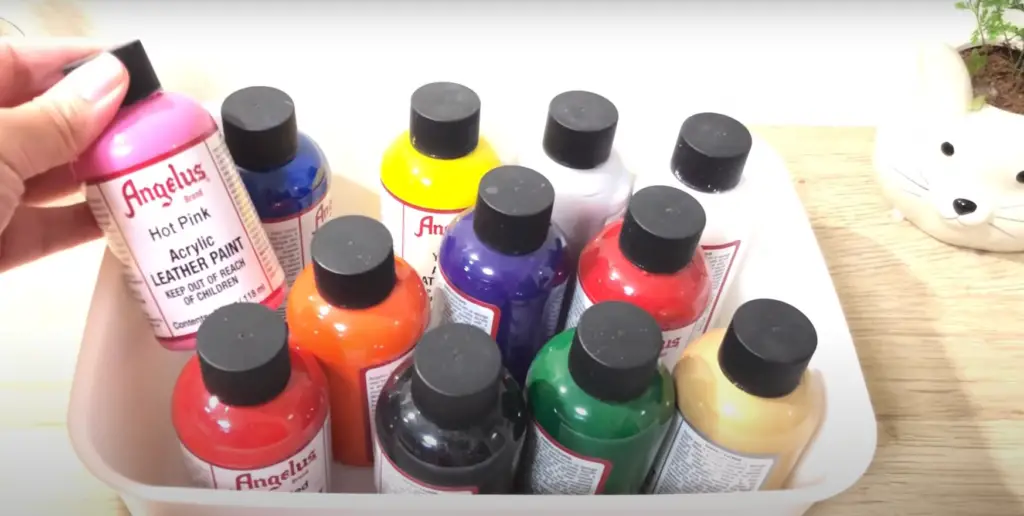
Whether or not you should use fabric paint for your project will ultimately depend on your specific needs and preferences. If you are looking for durable paint that can withstand a lot of wear and tear, you may want to consider another type of paint. However, if you are working on a project where durability is not as important, fabric paint can be a good option [2].
What Is The Difference Between Fabric Paint And Acrylic Paint?
There is a big difference between fabric paint and acrylic paint, even though they are both made of pigments in a water-based solution.
Choosing between fabric paint and acrylic paint for your project will depend on the final look you want to achieve and how long you need it to last. If you’re looking for a more temporary solution, acrylic paint is a better choice. However, if you want the design to be permanent, fabric paint is the way to go [3].
How to Paint Leather Shoes with Acrylic Paint
Step 1: Prep the Shoes/Bag/Leather Piece
To prepare your shoes (or any other leather piece) for painting, start by giving them a good cleaning. If they’re new, you can just wipe them down with a damp cloth. If they’re used, you may need to scrub them with soap and water to remove any dirt or build-up. Once the shoes are clean, let them dry completely. Next, you’ll want to sand the shoes to create a rough surface for the paint to adhere to. You can use sandpaper or a power sander for this step. If you’re using sandpaper, start with a coarse grit and move to a finer grit until the shoes are evenly sanded.
Step 2: Prime the Item
After the shoes are sanded, you’ll need to apply a primer. This will help the paint adhere to the leather and create a more even finish. You can use any type of primer designed for leather or vinyl. Apply the primer with a brush or roller and let it dry according to the manufacturer’s instructions.
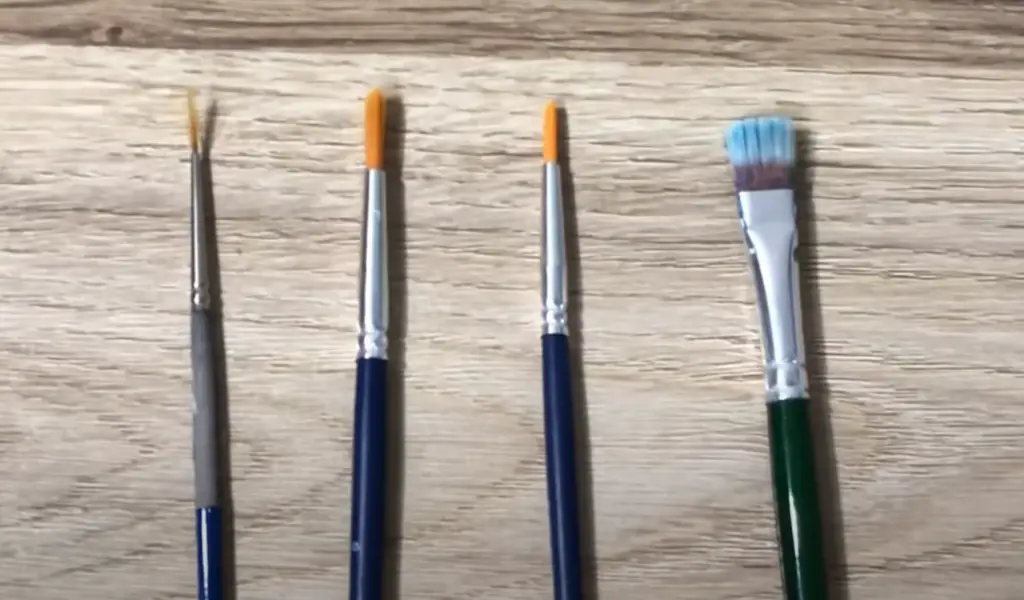
Step 3: Paint the Item
Once the primer is dry, you’re ready to start painting. You can use any type of paint designed for leather or vinyl. Acrylic paint is a good option because it’s easy to work with and dries quickly. Apply the paint with a brush or roller, using light, even strokes. Let the paint dry according to the manufacturer’s instructions before applying a second coat.
Step 4: Seal the Item
After the final coat of paint is dry, you’ll need to seal the shoes to protect the finish. You can use any type of sealer designed for leather or vinyl. Apply the sealer with a brush or roller and let it dry according to the manufacturer’s instructions [4].
How to Prevent Acrylic Paint from Cracking?
Acrylic paint is a versatile medium that can be used on a variety of surfaces, including leather. However, if not properly prepped or sealed, it can crack and peel over time.
Here are some tips on how to prevent your acrylic paint from cracking on leather items:
- Always clean the surface of your item before painting them. This will remove any dirt, oil, or other debris that could prevent the paint from adhering properly;
- Use a primer designed for leather before painting. This will help to create a smooth surface for the paint to adhere to and will also help to extend the life of your paint job;
- Seal the paint with a clear topcoat after it has dried. This will protect the paint from cracking and peeling, and will also make it more resistant to wear and tear;
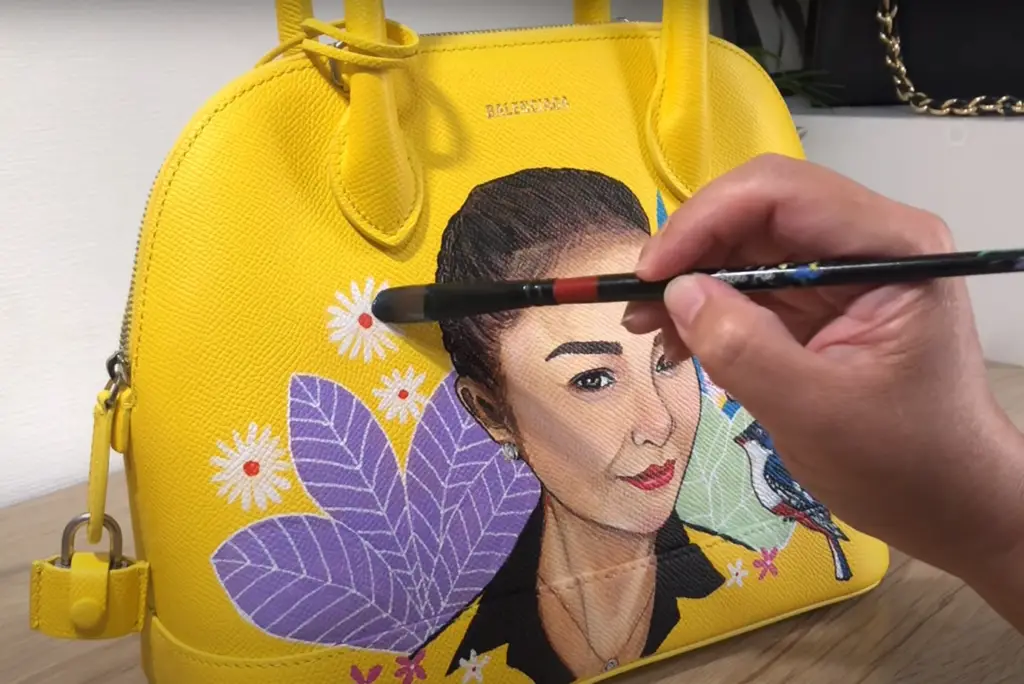
Fabric paints are specially formulated to be used on fabric, so they should work fine on leather. However, as with any paint, it’s always a good idea to test a small area first to make sure there are no adverse reactions.
FAQ
Can you paint fabric paint on leather?
The short answer is yes, you can paint fabric paint on leather. However, there are a few things to keep in mind before doing so. First, it’s important to choose the right type of fabric paint. not all fabric paints are created equal, and some are better suited for leather than others. You’ll also want to prep the leather before painting, and be sure to seal the paint once it’s dry to prevent it from cracking or peeling over time.
Will the paint stick to the leather?
The paint will stick to the leather, but it might not be as durable as you would like. You should test the paint on a small area of the leather before committing to the project.
What is the best type of fabric paint to use on leather?
There are a few different types of fabric paint that can be used on leather. Acrylic paint is a good option, as it’s durable and easy to find. You can also use leather dye, though this can be more difficult to work with. Another option is to use a leather-specific fabric paint, which can be found at most craft stores.
Can I use fabric paint on a leather couch?
You can use fabric paint on a leather couch, but it’s important to choose the right type of paint and prep the leather first. Acrylic paint is a good option for painting a leather couch. You’ll also want to make sure the paint is sealed once it’s dry to prevent cracking or peeling.
Can I seal the fabric paint with a clear coat?
Yes, you can seal the fabric paint with a clear coat. This will help to prevent the paint from cracking or peeling over time. You can find clear coats at most hardware stores.
Does fabric paint work on fake leather?
Yes, fabric paint will work on fake leather. However, it’s important to choose the right type of paint and prep the surface before painting. Acrylic paint is a good option for painting fake leather. You’ll also want to make sure the paint is sealed once it’s dry to prevent cracking or peeling.
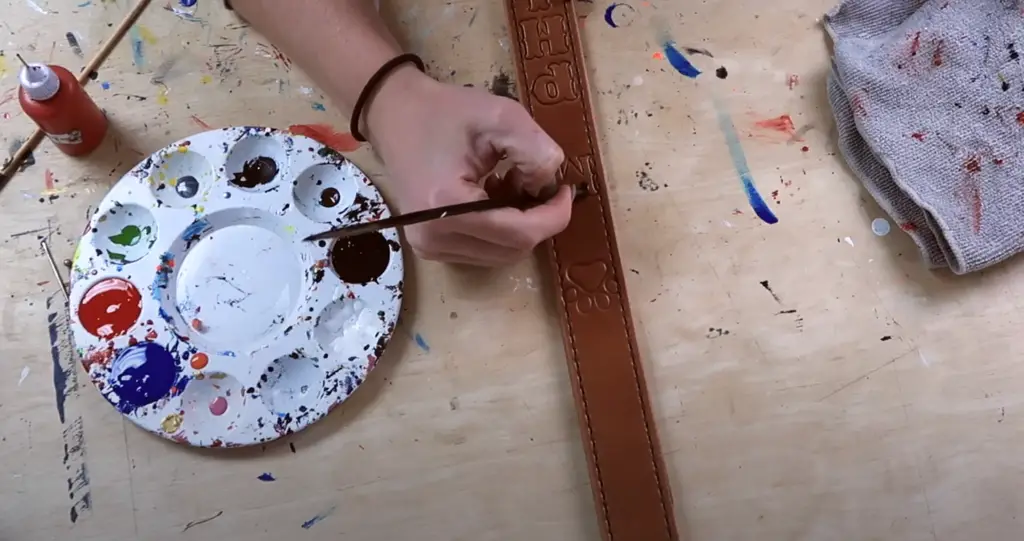
How long does paint on leather last?
The lifespan of paint on leather will depend on a few factors, including the type of paint used and how well the leather is cared for. Generally speaking, however, you can expect the paint to last for several years.
What do I need to paint on the leather?
In addition to the fabric paint, you’ll need a few other supplies before getting started. These include a piece of leather to paint on, a brush or sponge for applying the paint, and a sealer (if desired). You can find all of these supplies at most craft stores.
Can I use regular paint on leather?
No, you should not use regular paint on leather. Regular paint is not designed for use on leather and will not adhere properly. It can also crack and peel over time. If you want to paint leather, be sure to choose a fabric paint specifically designed for use on this material.
Can I add designs or patterns to the leather with fabric paint?
Yes, you can add designs or patterns to the leather with fabric paint. Fabric paint comes in a variety of colors, so you can be as creative as you like. You can also find fabric paint in different finishes, such as glossy or matte.
How do I remove fabric paint from leather?
If you need to remove fabric paint from leather, you can do so with a few household supplies. First, soak a cotton ball in rubbing alcohol. Then, gently rub the stained area with the cotton ball until the paint comes off. You may need to repeat this process several times to remove all of the paint. If the stain is stubborn, you can also try using a mild abrasive, such as baking soda or salt. Be sure to test any cleaner or abrasive on an inconspicuous area of the leather before using it on the stain.
Useful Video: What you need to know if you want to paint on leather bags
Conclusion
So, can you use fabric paint on leather? The answer is yes, but there are some things to keep in mind. Fabric paint can be used on leather, but it will not penetrate the material as it does with fabric. This means that the paint will sit on top of the leather and may eventually crack or peel off. It’s important to test a small area first and to use a primer if you’re planning on using a lot of paint. If you take these precautions, you should be able to successfully use fabric paint on leather.
References:
- https://theartsuppliers.com/fabric/does-fabric-paint-work-on-leather/
- https://ivisualarts.com/5-benefits-of-fabric-paint-that-helps-beginners-a-lot/
- https://crafticworld.com/fabric-paint-vs-acrylic-paint/
- https://painttopics.com/acrylic-paint-on-leather/




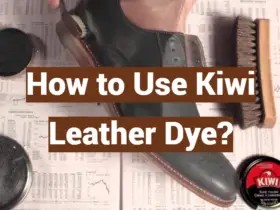


As someone who enjoys crafting and repurposing old leather goods, I’ve tried using fabric paint on leather several times. The paint adheres decently if the leather is properly prepared, but I’ve found the finish to be quite stiff and inflexible. No matter how thin I apply the paint, it limits the natural movement of the leather. It also tends to crack and peel off over time with wear. I’d only recommend fabric paint on leather items that won’t be flexed or moved much. For items like purses or shoes, I’d suggest leather paints or dyes instead.
I made the mistake of using fabric paint on a leather jacket once and really regretted it. Even though I sealed the paint with an acrylic finisher, it started noticeably cracking within just a few wears. The painted areas lost all pliability. When I bent my arm, the paint would crack apart. And the acrylic sealant would flake off bit by bit over time too. I won’t make that mistake again. Leather paints bond much better and maintain the flexibility of the leather. Fabric paint just sits stiffly on top of the leather.
As an artist who enjoys decorating and customizing leather goods, I’ve experimented with many different paints and finishes. When using fabric paint on leather, it takes very thin, controlled layers to avoid heavy cracking and flaking over time. But even when applied properly, fabric paint inhibits the natural flexibility of leather. Areas painted with fabric acrylicsbecome quite stiff. Leather paints and dyes soak into the leather better and move with the bend of the material. I only use fabric paints sparingly for small accents and details, not large designs.
I tried using some leftover fabric paint on an old leather purse, thinking I could give it a fun, colorful makeover. Big mistake! The paint looked okay at first, but after carrying the purse around for a few weeks, it started flaking off in chunks. I was finding paint flakes and crumbs at the bottom of the bag constantly. The paint was not adhering well to the leather at all. I had to scrub it all off and start over with proper leather paint. Fabric paint is made for fabric – not the smooth, slippery surface of leather. Learn from my mistake!
As someone who upcycles thrift store finds into fun DIY projects, I was excited to try jazzing up a basic leather tote with some bright fabric paint. It adhered decently at first but then quickly started showing cracks and peeling, especially along the folds when I set the bag down. The bag lost its nice slouch and flexibility. I won’t be making that mistake again! Proper leather paints and dyes are the way to go for leather projects. Fabric paint is the wrong choice for any leather item that gets bent, folded, or flexed at all.
I really don’t recommend using fabric paint on leather goods like shoes or jackets. I tried adding some floral designs to an old pair of leather boots with fabric paint. Even using thin layers, the paint made the leather much stiffer in those areas. The boots creased and cracked badly along the painted designs with wear. And eventually the paint just flaked right off along the edges and high-flex areas. Leather deserves paints and treatments specifically formulated for its properties. Standard fabric paint just doesn’t adhere well or flex.
As an avid crafter, I was really excited to try some new fabric paints on a basic leather belt to give it a fun, colorful update. Big mistake! The paint adhered okay initially but very quickly started cracking and losing flexibility as I wore the belt. The painted area got so stiff it would actually dig into my waist when I bent over. And the paint would flake off in chips and crumbs. Fabric paint just sits on top of leather – it doesn’t properly bond or flex. Don’t make my mistake, use leather-specific paints only!
I recently tried adding some fabric paint designs to a faux leather jacket. Despite using multiple thin layers, the paint began cracking after the very first wear. When I bent my elbows, the paint over the joints started flaking off immediately. The acrylic just sits on top of the leather. It doesn’t properly bond or flex with the bend of the material. Maybe fabric paint would work better on genuine leather, but on faux I’d avoid it. Faux leather deserves flexible paints designed for its properties.
As someone who loves DIY projects, I was excited to try jazzing up some basic leather boots using fabric paints. It seemed like a fun, affordable way to customize them into really unique statement pieces. Unfortunately the paint just didn’t adhere well to the smooth leather at all. Even with light layers and sealing, the paint cracked and peeled off very quickly. Leather boots and shoes see a lot of creasing and bending that fabric paint just can’t withstand. Stick to leather-specific paints and dyes for best results.
I recently tried to use some extra fabric paint I had to add a fun design to my favorite leather purse. I thought thin, multiple layers sealed with an acrylic finish would do the trick. While it looked cute initially, the paint almost immediately started flaking and peeling off along the purse folds with daily use. The leather became so stiff in the painted areas too! Fabric paint does not hold up well on leather at all. For genuine leather bonding and flexibility, always use paint formulated specifically for leather.
As an artist and crafter, I was really intrigued by the idea of trying regular fabric paint on leather. I thought maybe I could get some cool effects by layering and blending. Unfortunately the results were disappointing. The paint cracked and peeled off with even slight flexing of the leather. And it made the surface area very stiff and inflexible overall. I definitely don’t recommend fabric paint for any leather goods that will be folded or creased in any way. Stick to specialized leather paints and dyes for the best, long-lasting results.
I recently tried to use some standard acrylic fabric paint on a thrifted leather jacket to give it a colorful, funky update. Despite properly preparing the leather and carefully applying thin coats, the paint almost immediately started showing cracks and peeling off. The paint just doesn’t properly bond with the smooth surface of leather. Even faux leather is too slippery for fabric paint. Leather deserves specialty paints or dyes formulated specifically for adhering to and flexing with leather. Don’t make my mistake – avoid fabric paint!